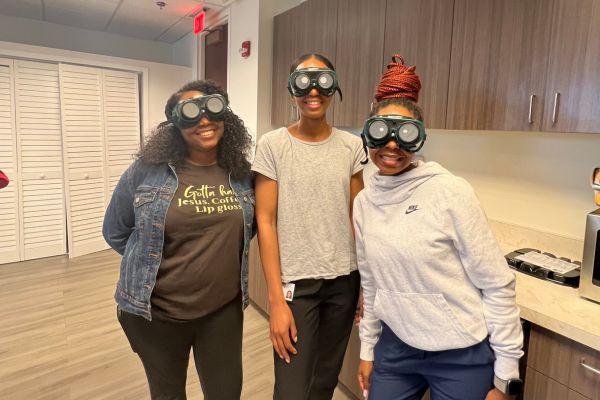OTD Program Helps to Meet Growing Low Vision Needs

The Occupational Therapy Doctorate program is at the center of efforts to make low-vision rehabilitation resources more accessible for the growing number of people who need them.
After completing the new course last spring, five OTD students are working toward earning their Low Vision Rehabilitation Certificate. Each year, a limited number of OTD students can apply to take the Low Vision Rehabilitation Course in cooperation with the Duke Eye Center’s Rehabilitation and Performance Division.
After completing the 14-week course, students must complete a 350-hour fieldwork or capstone experience before taking the credentialing exam. The next course will be offered in the spring of 2024. Class of 2024 students pursuing the certification are Jazmin Ritcher, Jasmine Campbell, Stephanie Timmons, Erica Wilson, and Sherwina Adams.
In July, Tomeico Faison, OTD, OTR/L, and Kimberly Hreha, EdD, OTR/L, joined colleagues from Duke Eye Center’s Vision Rehabilitation and Performance Division at the International Society of Low Vision Research and Rehabilitation (ISLRR) Conference in Denver, Colorado, held July 24-27.
The presentations highlighted Duke’s growing leadership in vision rehabilitation through its inter-professional collaboration between optometrists and occupational therapists. Dr. Hreha and Dr. Faison presented a poster on – Creating a Low Vision Certificate Program for Duke’s OTD Students.
The Duke Eye Center’s Diane Whitaker, OD, presented Shifting the Paradigm: OT 1st Service Model to Meet the Unique Needs of the Aging Population with Vision Loss, which was co-authored by: Omar Mohiuddin, MPH, MS, OTR/L, Fay Tripp, CDRS, MS, OTR/L, Madison Dunning, OD, and Dr. Hreha.
Duke OTD’s low vision certificate program is one of only three in the nation accredited by the Academy of Certification of Vision Rehabilitation and Education Professionals.
Dr. Faison said approximately 140 million people worldwide have low vision, and 35 million need comprehensive rehabilitation services. This figure is expected to increase due to population growth and aging.
“There is a significant need to train more occupational therapists to treat clients with low vision, and programs like ours are well positioned to train more students and working professionals,” she said.
Faison said the long-term goal is to expand the program to include more OTD students and an option to certify working OTs.